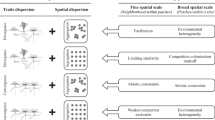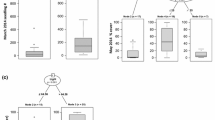Abstract
To link spatial patterns and ecological processes, we analysed the distribution of two shrub species (one large and dominant, the other smaller) and estimated the reproductive consequences of their distribution for the smaller species. We tested the significance of the spatial distribution pattern of the two shrubs by second-order bivariate point pattern analysis (Ripley's K function). Performance of Asparagus albus, the smaller shrub, was measured as (1) survival of transplanted seedlings in two contrasting habitats: patches of the dominant shrub (Ziziphus lotus), and open interspaces; and (2) reproductive output of plants naturally occurring in both habitats. The two species were significantly aggregated. Transplanted Asparagus albus seedlings had higher survival rates in patches than in the open. Plants produced more flowers, fruits, and showed a higher mass of seeds when living in aggregates than when isolated. The mechanisms responsible for this facilitative effect seem to be related to soil enrichment in patches. These results suggest that the spatial aggregation of species can be indicative of a positive interaction among them, directly affecting fitness of at least one of the species. Facilitation, by inducing variations in the reproductive performance may play a major role in the demography and dynamics of plant populations.




Similar content being viewed by others
References
Aguiar MR, Sala OE (1999) Patch structure, dynamics and implications for the functioning of arid ecosystems. Trends Ecol Evol 14:273–277
Bertness MD, Callaway RM (1994) Positive interactions in communities. Trends Ecol Evol 9:191–193
Brooker RW, Callaghan TV (1998) The balance between positive and negative plant interactions and its relationship to environmental gradients: a model. Oikos 81:196–207
Burd M (1994) Batemans's principle and plant reproduction: the role of pollen limitation in fruit and seed set. Bot Rev 60:83–139
Callaway RM (1995) Positive interactions among plants. Bot Rev 61:306–349
Callaway RM, Walker LR (1997) Competition and facilitation: a synthetic approach to interactions in plant communities. Ecology 78:1958-1965
Callaway RM, Brooker RW, Choler P, Kikvidze Z, Lortie CJ, Michalet R, Paolini L, Pugnaire FI, Newingham B, Aschehoug ET, Armas C, Kikodze D, Cook BJ (2002) Positive interactions among alpine plants increase with stress. Nature 417:844–848
Chacon P, Bustamante RO (2001) The effects of seed size and pericarp on seedling recruitment and biomass in Cryptocarya alba (Lauraceae) under two contrasting moisture regimes. Plant Ecol 152:137–144
Chapin FS III, Walker LR, Fastie CL, Sharman LC (1994) Mechanisms of primary succession following deglaciation at Glacier Bay, Alaska. Ecol Monogr 64:149–175
Czárán T, Bartha S (1992) Spatiotemporal dynamic models of plant population and communities. Trends Ecol Evol 7:38–42
Dale MRT (1999) Spatial pattern analysis in plant ecology. Cambridge University Press, Cambridge
Dawson TE, Ehleringer JR (1991) Ecological correlates of seed mass variation in Phoradendron juniperinum a xylem-tapping mistletoe. Oecologia 85:332–342
Diggle PJ (1983) Statistical analysis of spatial point patterns. Academic Press, London
Eccles NS, Esler KJ, Cowling RM (1999) Spatial pattern analysis in Namaqualand desert plant communities: evidence for general positive interactions. Plant Ecol 142:71–85
Egerton JJG, Banks JCG, Gibson A, Cunningham RB, Ball MC (2000) Facilitation of seedling establishment: Reduction in irradiance enhances winter growth of Eucalyptus pauciflora. Ecology 81:1437–1449
Getis A, Franklin J (1987) Second-order neighborhood analysis of mapped point patterns. Ecology 68:473–477
Haase P (1995) Spatial pattern analysis in ecology based on Ripley's K-function: Introduction and methods of edge correction. J Veg Sci 6:572–582
Haase P (2001) Can isotropy vs anisotropy in the spatial association of plant species reveal physical vs abiotic facilitation? J Veg Sci 12:127–136
Haase P, Pugnaire FI, Clark SC, Incoll LD (1997) Spatial pattern in Anthyllis cytisoides shrubland on abandoned land in southeastern Spain. J Veg Sci 8:627–634
Herrera CM (1991) Dissecting factors responsible for individual variation in plant fecundity. Ecology 72:1436–1448
Herrera CM (2000) Individual differences in progeny viability in Lavandula latifolia: a long-term field study. Ecology 81:3036–3047
Holzapfel C, Mahall BE (1999) Bidirectional facilitation and interference between shrubs and annuals in the Mojave desert. Ecology 80: 1747–1761
Howard TG, Goldberg DE (2001) Competitive response hierarchies for germination growth and survival and their influence on abundance. Ecology 82:979–990
Kikvidze Z, Nakhutsrishvili G (1998) Facilitation in subnival vegetation patches. J Veg Sci 9:261–264
Montaña C (1992) The colonization of bare areas in two-phase mosaics of an arid ecosystem. J Ecol 80:315–327
Pugnaire FI, Luque MT (2001) Changes in plant interactions along a gradient of environmental stress. Oikos 93:42–49
Pugnaire FI, Haase P, Puigdefábregas J, Cueto M, Incoll LD, Clack SC (1996a) Facilitation and succession under the canopy of the leguminous shrub Retama sphaerocarpa in a semi-arid environment in south-east Spain. Oikos 76:455–464
Pugnaire FI, Haase P, Puigdefábregas J (1996b) Facilitation between higher plant species in a semiarid environment. Ecology 77:1420–1426
Reynols JF, Virginia RA, Kemp PR, de Soyza AG, Tremmel DC (1999) Impact of drought on desert shrubs: Effects of seasonality and degree of resource island development. Ecol Monogr 69:69–106
Ripley BD (1976) The second-order analysis of stationary processes. J Appl Probab 13:255–266
Rousset O, Lepart J (2000) Positive and negative interactions at different life stages of a colonizing species (Quercus humilis). J Ecol 88:401–412
Schlesinger WH, Reynolds JF, Cunninghan GL, Huennke LF, Jarrell WM, Virginia RA, Whitford WG (1990) Biological feedback in global desertification. Science 247:1043–1048
Sharpe C (1991) Spatial patterns and dynamics of woody vegetation in an arid savanna. J Veg Sci 2:565–572
Shmida A, Ellner S (1984) Coexistence of plant-species with similar niches. Vegetatio 58:29–55
Shumway SW (2000) Facilitative effects of a sand dune shrub on species growing beneath the shrub canopy. Oecologia 12:138–148
Stachowicz JJ (2001) Mutualism, facilitation, and structure of ecological communities. Bioscience 51:235–246
Steinberg EK, Kareiva P (1997) Challenges and opportunities for empirical evaluation of 'Spatial Theory'. In: Tilman D, Kareiva P (eds) Spatial ecology. The role of space in population dynamics and interspecific interactions. Princeton University Press, Princeton, N.J., pp 318–332
Stephenson AG (1981) Flower and fruit abortion: proximate causes and ultimate functions. Annu Rev Ecol Syst 12:253–279
Stoll P, Prati D (2001) Intraspecific aggregation alters competitive interactions in experimental plant communities. Ecology 82:319–327
Tewksbury JJ, Lloyd JD (2001) Positive interactions under nurse-plants: spatial scale stress gradients and benefactor size. Oecologia 127:425–434
Tielbörger K, Kadmon R (1995) The effect of shrubs on the emergence survival and fecundity of four coexisting annual species in a sandy desert ecosystem. Ecoscience 2:141–147
Tielbörger K, Kadmon R (2000) Temporal environmental variation tips the balance between facilitation and interference in desert plants. Ecology 81:1544–1553
Tirado R (2003) Positive interactions between plants in semi-arid communities: mechanisms and consequences. PhD thesis, University of Seville, Spain
Venable DL (1992) Size-number trade-offs and the variation of seed size with plant resource status. Am Nat 140:287–304
Weiner J (1988) The influence of competition on plant reproduction. In: Lovett Doust J, Lovett Doust L (eds) Plant reproductive ecology patterns and strategies. Oxford University Press, New York, pp 228–245
Went FW (1942) The dependence of certain annual plants on shrubs in Southern California deserts. Bull Torrey Bot Club 69:100–114
Wilson DS (1998) Adaptative individual differences within single populations. Philos Trans R Soc B 353:199–205
Winn A (1988) Ecological and evolutionary consequences of seed size in Prunella vulgaris. Ecology 69:1537–1544
Acknowledgements
We thank Juan Miguel Requena Mullor and Eduardo Narbona Fernández for helpful field assistance and stimulating discussions. Carlos M. Herrera, Chris Lortie and Michele Faisey made valuable comments on an earlier draft of this manuscript. Financial support was provided by the Spanish Ministry of Science and Technology (AMB98–1108-C04–01 and REN2001/1544-GLO).
Author information
Authors and Affiliations
Corresponding author
Rights and permissions
About this article
Cite this article
Tirado, R., Pugnaire, F.I. Shrub spatial aggregation and consequences for reproductive success. Oecologia 136, 296–301 (2003). https://doi.org/10.1007/s00442-003-1264-x
Received:
Accepted:
Published:
Issue Date:
DOI: https://doi.org/10.1007/s00442-003-1264-x




